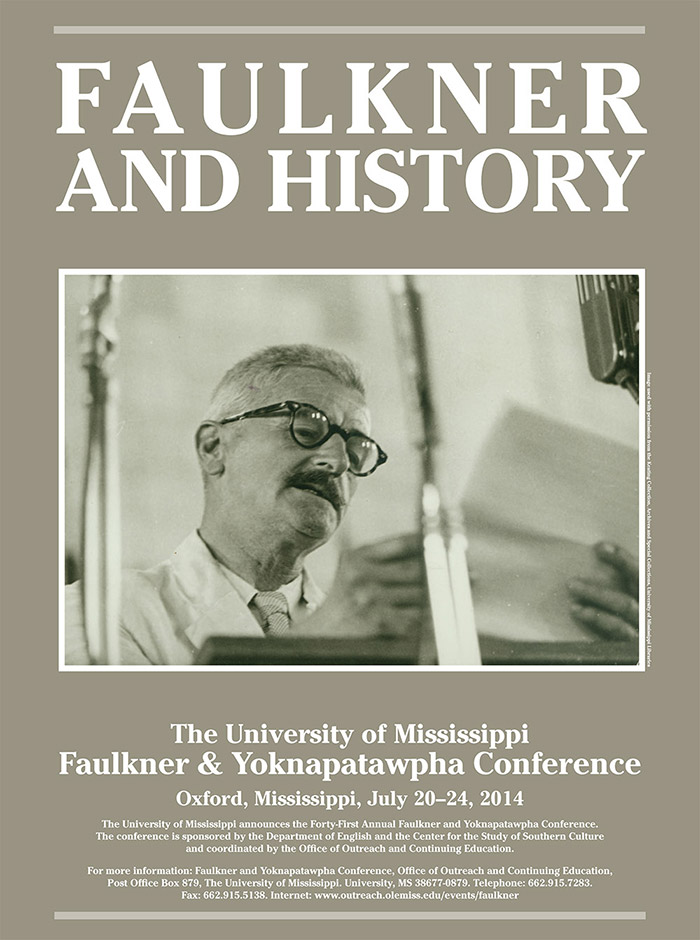
Panel. Moonshine and Magnolias: A History of Spirits in Faulkner's Mississippi
Location
Nutt Auditorium
Start Date
23-7-2014 3:30 PM
Description
- Booze and Borderlands: Historicizing Race and Class in the Liminal Spaces of Light in August and Sanctuary / Carrie Helms Tippen, Texas Christian University
The production, distribution, and consumption of illicit alcohol creates borderlands where the binary categories of race and class are destabilized. Rather than a history of alcohol alone, this presentation is a history of spaces: the forces that generated the demand for spaces, the persons and groups that met in such spaces, and the consequences of those meetings. I use this historic narrative to reinterpret the liminal spaces liquor creates in Faulkner’s works. In Light in August, the diner/brothel is a public space for conducting private acts. As a “white-only” space, the diner/brothel demands that Joe Christmas be assigned a discernable racial identity. Conversely, the Old Frenchman’s Place in Sanctuary is a private space turned public, merging Ruby Lamar’s home life with Lee Goodwin’s business. Ruby’s dining table and the porch, particularly, are borderlands where class status seems to lose some of its potency. - The Noble Experiment? Faulkner's Two Prohibitions / Conor Picken, Bellarmine University
Faulkner’s Sanctuary and Requiem for a Nun use the historical bookends of Prohibition and the Sobriety Movement to interrogate the South’s troubling reaction to social change. Both novels feature Temple Drake and Gowan Stevens, and the manner in which they consume across these texts ties them to the historical climate of Prohibition and the emerging culture of sobriety/recovery in its wake. Sanctuary features Temple and Gowan descending into of alcoholism, while Requiem for a Nun shows them struggling with recovery from it. Temple and Gowan’s troubled experiences with alcoholism pressure notions that historicized representations of drinking reflect the progressive intents of what I call Faulkner’s two Prohibitions - "We Thought It Was Whiskey": Prohibition in the Jim Crow South and Faulkner's Image of the Intemperate Negro / Meredith Kelling, University of Missouri, St. Louis
Prohibition in the South ought to be viewed as a movement not to inspire temperate behavior in all of its citizens—for the alcoholic behavior of established whites was famously overlooked—but to color-code the consumption of alcohol, to further an image of the African American slave descendant as a body in need of policing. In Faulkner’s oeuvre, that body belongs to Nancy Mannigoe. This paper will examine how varied perceptions of Nancy, in both 1931’s “That Evening Sun” and 1951’s Requiem for a Nun, problematize the stereotypical image of the intemperate Negro both by allowing for black subjectivity and by revealing the sanctioned paternalistic impulse to criminalize black behavior more generally. This paper provides a historical context for Nancy’s victimization, madness, and crime, that is, of Prohibition in the Jim Crow South, which sought to maintain slavery’s socioeconomic status quo by perpetuating an image of inherent black criminality.
Relational Format
Conference proceeding
Recommended Citation
Tippen, Carrie Helms; Picken, Conor; and Kelling, Meredith, "Panel. Moonshine and Magnolias: A History of Spirits in Faulkner's Mississippi" (2014). Faulkner and Yoknapatawpha Conference. 27.
https://egrove.olemiss.edu/fy/2014/schedule/27
COinS
Jul 23rd, 3:30 PM
Panel. Moonshine and Magnolias: A History of Spirits in Faulkner's Mississippi
Nutt Auditorium
- Booze and Borderlands: Historicizing Race and Class in the Liminal Spaces of Light in August and Sanctuary / Carrie Helms Tippen, Texas Christian University
The production, distribution, and consumption of illicit alcohol creates borderlands where the binary categories of race and class are destabilized. Rather than a history of alcohol alone, this presentation is a history of spaces: the forces that generated the demand for spaces, the persons and groups that met in such spaces, and the consequences of those meetings. I use this historic narrative to reinterpret the liminal spaces liquor creates in Faulkner’s works. In Light in August, the diner/brothel is a public space for conducting private acts. As a “white-only” space, the diner/brothel demands that Joe Christmas be assigned a discernable racial identity. Conversely, the Old Frenchman’s Place in Sanctuary is a private space turned public, merging Ruby Lamar’s home life with Lee Goodwin’s business. Ruby’s dining table and the porch, particularly, are borderlands where class status seems to lose some of its potency. - The Noble Experiment? Faulkner's Two Prohibitions / Conor Picken, Bellarmine University
Faulkner’s Sanctuary and Requiem for a Nun use the historical bookends of Prohibition and the Sobriety Movement to interrogate the South’s troubling reaction to social change. Both novels feature Temple Drake and Gowan Stevens, and the manner in which they consume across these texts ties them to the historical climate of Prohibition and the emerging culture of sobriety/recovery in its wake. Sanctuary features Temple and Gowan descending into of alcoholism, while Requiem for a Nun shows them struggling with recovery from it. Temple and Gowan’s troubled experiences with alcoholism pressure notions that historicized representations of drinking reflect the progressive intents of what I call Faulkner’s two Prohibitions - "We Thought It Was Whiskey": Prohibition in the Jim Crow South and Faulkner's Image of the Intemperate Negro / Meredith Kelling, University of Missouri, St. Louis
Prohibition in the South ought to be viewed as a movement not to inspire temperate behavior in all of its citizens—for the alcoholic behavior of established whites was famously overlooked—but to color-code the consumption of alcohol, to further an image of the African American slave descendant as a body in need of policing. In Faulkner’s oeuvre, that body belongs to Nancy Mannigoe. This paper will examine how varied perceptions of Nancy, in both 1931’s “That Evening Sun” and 1951’s Requiem for a Nun, problematize the stereotypical image of the intemperate Negro both by allowing for black subjectivity and by revealing the sanctioned paternalistic impulse to criminalize black behavior more generally. This paper provides a historical context for Nancy’s victimization, madness, and crime, that is, of Prohibition in the Jim Crow South, which sought to maintain slavery’s socioeconomic status quo by perpetuating an image of inherent black criminality.

